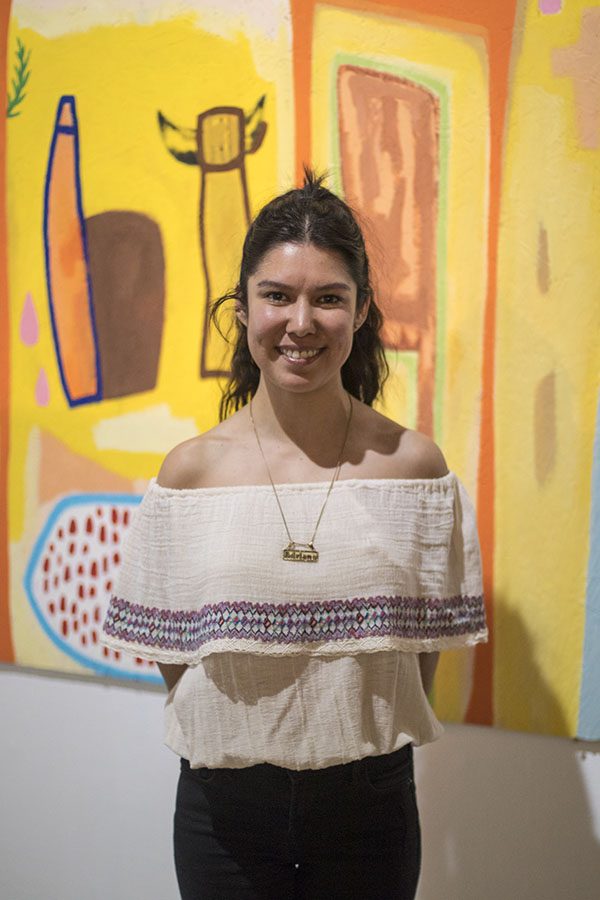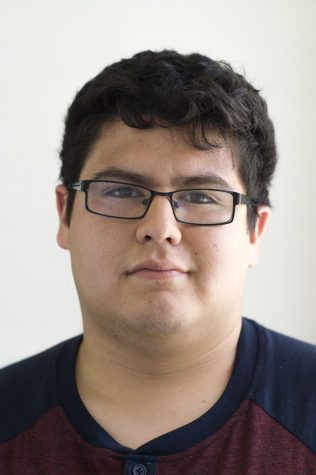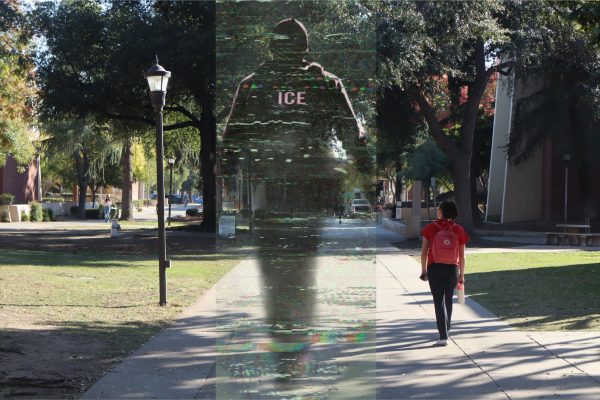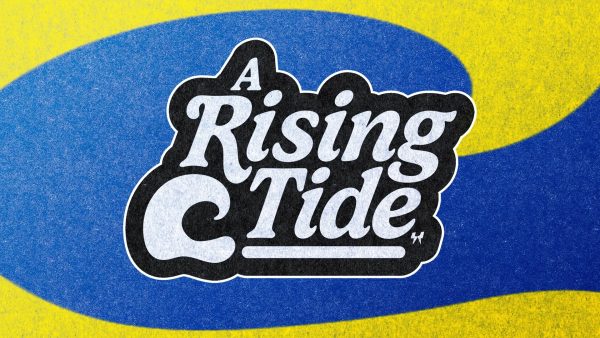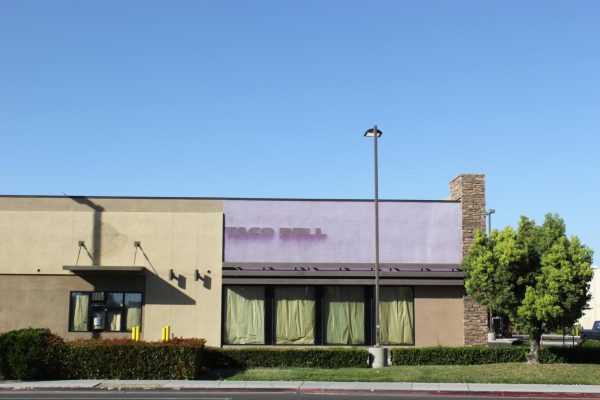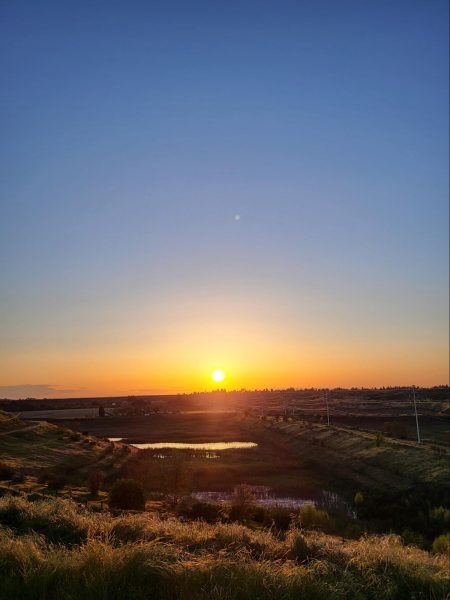Adrianna Alejo Sorondo is Healing through Art
Photo by: Larry Valenzuela
Adrianna Alejo Sorondo showcases her art work at the “Thickets” exhibit at the Fresno City College Art Space Gallery on Thursday, March 1, 2018.
Fresno artist Adrianna Alejo Sorondo, 30, sits cross-legged on the floor of Fresno City College’s Art Space Gallery. She peels an orange, while exploring the intricacies of everyday life. She is soft-spoken, words carefully selected, frequent pauses to allow reflection. A stillness that is difficult to pinpoint but is profoundly felt, exists within her.
Sorondo is one of the six women whose work is being featured in “Thickets,” a multi-disciplinary, intergenerational exhibit, exploring feminist themes in the Art Space Gallery, open through April 6.
“Home Sign,” an ode to Sorondo’s mother, is an immersive art installation featuring a home video, flowers, trinkets and plants all from her local market or neighborhood. Sorondo explores the complexities that encompass her, her Mexican-American background and experience being raised by a deaf mother.
“This specific piece I wanted to honor my mom, because this show is about communication and feminism,” Sorondo said. “All these things that make me up, I feel like, are from my mom. I am the way I am because of her.”
Sorondo was born and raised in Fresno in a neighborhood called Highway City. She is a mixed media artist and a self taught painter; her first introduction to art was through her mother.
“She’s always just made things with me and given me materials and just told me to use my imagination,” Sorondo said.
Sorondo began to immerse herself in painting when she was 14. She began to suffer from insomnia and loathed going to school. She was diagnosed with depression and anxiety.
“They gave me a bunch of medication and I just felt so weird, like a zombie,” Sorondo said. “I started painting to focus and calm down, and I just decided I can heal myself; I don’t need any of this other stuff.”
Sorondo has been able to create a space of her own through art. She said she’s been able to explore her Mexican-American identity without the confines of language, space or time.
“The identity aspect of my art comes from not being enough,” Sorondo said, “not American enough, not Mexican enough.”
Sorondo said, “There used to be this girl, she went to high school with me, and she would always say, ‘you’re not that Mexican’, and that always bothered me, I never knew why.”
Sorondo was the first in her family to go to college. She attended San Francisco State, and received her bachelor’s degree in anthropology. She approaches her art through an anthropological perspective, her practice is centered on being still.
“You just sit and think. ‘Who am I?’ ‘What do I want to put out there?’ ‘What do I want other people to feel’, or ‘how do I get other people to feel what I feel?’” she said.
Sorondo said she had to overcome the anxiety attached to an artist’s lack of financial stability in respect to Mexican-American expectations of success.
Her work intertwines traditional Mexican healing practices with contemporary art, a result of her interest in flower medicine.
“Flowers are healing, but they’re healing in all ways; it’s not just dry them and make a tea,” Sorondo said. “Growing them, or talking to them, just gathering something and taking them to a friend, that’s medicine too.”
Sorondo currently works at an Indian restaurant, has her own art studio at Broadway Studios in downtown Fresno, runs a garden at Fresno County Juvenile Justice Campus, works as a substitute teacher, and does spiritual cleanses on the side.
“I think it’s really important to be a bunch of things at once,” she said.
Last spring, Sorondo began promoting “fuck boi limpias,” a traditional Mexican healing cleanse aimed at men who won’t commit. She also offers saging of phones for drunk texts.
Her “fuck boi limpias” were a way of connecting younger generations to traditional medicine through a more accessible lens.
“I also like to have humor in my art; I want it to be accessible; I want people to feel they can do this too,” she said. “It’s not like some crazy thing you can only see on TV, or there’s only one person that can do it.”
She said she wants people coming to her show to see that there’s “a magic or a wonderment in everyday life if we just take the time.”
One of her paintings is outlined in green. It was inspired by witnessing a comet of the same hue streaking across the night sky when she was driving.
“I just remembered thinking that was crazy, and I wonder how many people saw that,” she said. “That’s a little gift you get for looking up at the sky.”
Sorondo says her love of installation art stems from showcasing the temporary nature of everyday life.
“That’s why I use fresh flowers, things that aren’t going to last forever,” Sorondo says. “Because it’s like you either show up or you don’t. You either get to see it, or you don’t.”
She wants people to know that it’s possible to “heal yourself with the things around you.”
“Not that it’s simple, but it’s available if you’re willing to be silly or to just look, to be quiet,” Sorondo said. “Just looking at the wind blow at the grass and just being grateful that you can see that. That’s what makes life good, those are the things that stick with you through time.”
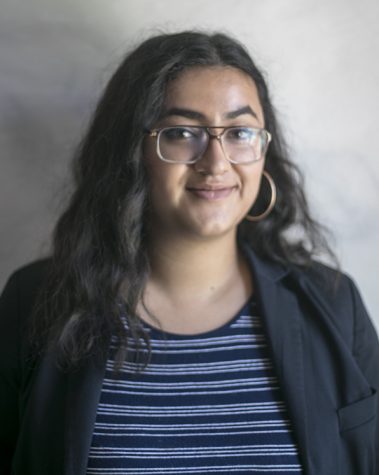
Paulina Rodríguez is a 21-year-old journalism major attending Fresno City College. She grew up in Chavinda, Michoacán, Mexico and immigrated to the United...

